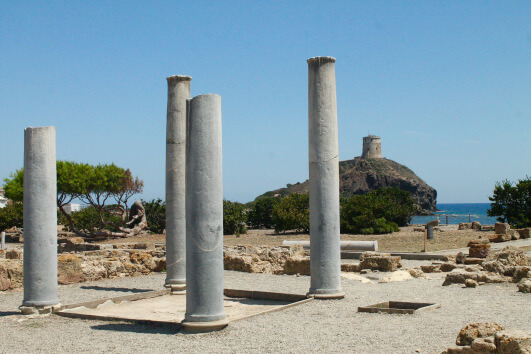In Part-1 of this study, we noted that Sardinia was called Ichnusa (the Latinised form of Greek Hyknousa), Sandalion, Sardinia and Sardo by the ancient Greeks and the Romans. And the term SARDONIC was the adjective of Sardinia. We examined many Sardinia related names and words. Among them, we looked at four different Sardinia related words: Sardonic, Sandalion, Hyknousa and Ichnusa. By deciphering the word “Sardonic” we found, inherent in the name, the following definitions in Turkish that were applicable to the
Sardinians as their attributes:
“Turanians”; “Tanri believers”; “Sky-Turks; Lord Turks”; “Turks from Turkiye”, “people from Anatolia”; “Tur/Turk man”; “watermen”; “Saka men (Saka Turks)”, “Pelasgians; “fishermen”; “men of ocean”; “soldiers of the Sun”; “soldier people”; “followers of the sun”, “Sun worshipping people”;”the readers of written works”; “the top readers of written works”; “the readers of secrets”; “the readers of the winds”; “the readers of the God”; “water studying men”; “men of ocean waters”; “sheep breeder men”; “cattle breeder men”; “yellow wood dealers”; “knowledge people, light people”; “wearing yellow pants”, “yellow pants people” .
Also by deciphering the name SANDALION, we found the following definitions in Turkish that were relevant to the Sardanians: “house of boats”; “boat owners”; “boat builders”; “from Anatolia”, that is, “were originally Anatolians”.
And by deciphering the Greek name HYKNOUSA, we have the following attributes for Sardinians. The Sardinians were:
“House of Sun”; “house of Lord Oguz”; “Sky-Oguz lords ” (Sky-Turk lords); “house of Saka Lords”, “house of Saka Turks”,”house of Saka Huns”; “supreme lords of the water”; “school people”, “learned people”; “houses of light”, “houses of enlightenment”, “houses of learned people”; “good speaker”, “good language”; “ocean going people”, “open sea people”; “people who studied water”; “people who brought running water to houses”; “boat makers, boat owners, boat operators, boatmen”; “people who breeded sheep”; “cattle lords”, “house of cattle”; “sky-wise lords”; “village-wise lords”; “people who washed themselves”.
And from the Latin name ICHNUSA, we deciphered the following definitions in Turkish that are applicable as attributes for the Sardinians. The Sardinians were: “a house of sun”; “sun and moon people”; “sky light” or “light lord” people; “sunlight” people; “the water lord”, “the Saka lord” people; “water man”, like “water living life”; “soldier man”; “school people”, “learned people”; “fliers?”, “flying people?” ß(this needs to be verified yet!); “sheep breeders”.
***
So, the Sardinians, being the readers and writers of many fields, particularly, being masters of water and light related subjects and their scientific understanding of nature in their time, were enlightened people who endured the harsh conditions of their environment by ingenious solutions to their problems. The Sardinian NURAGHES are one of their best built and long-standing ancient architectural creations. Their knowledge and enlightenment are reflected even in the names NORA and NURAGHE or SU NURAGHE.
The name NORA, the ancient capital city of Sardinia, has a linguistic kinship with the Sardinian name NURAGHE. The name NORA is actually from Turkish “NUR E” (NUR Evi) meaning “house of Light”. NORA is said to have been built by the Phoenicians, that is, the Turanian GÜNHANS in Turkish – meaning the “Sun Lords”. Sun and light are inseparable entities. In addition to the word IŞI (IŞU, ŞUA) for light in Turkish, there is also the word NUR meaning “light”. The Phoenicians, Carthaginians, Etruscans, Corsicans, Sicilians Pelasgians, Minoans, Anatolians were all linguistically and culturally related Turanians of the ancient world. The following background information given at url http://italytourtravel.com/tours/unknown-sardinia-island.htm is enlightening :
“. . . . Nora the ancient capital of Sardinia. A sixteenth-century tower dominates a promontory by which you may see the vestiges of the ancient town, that was founded by Phoenicians as a double port of call for their sea trading: one port sheltered from the west wind and another shielded from the mistral. Nora began a Punic and then a Roman city, but it disappeared around the third century B.C., perhaps because of a cataclysm. Today it is possible to visit the remains of a Punic background, of Roman buildings, of a Punic-Roman temple, of thermal baths decorated with beautiful mosaics and above all a practically intact theatre which date back to the Imperial era. It is very interesting to discover the ancient water supplying system, with its big underground ducts, the mosaics with fine decorating or mechanical drawings. The sea still preserves a part of the old city of Nora, that sinked because of an earthquake. Many buildings are no more recognizable under the crusts of sea and time. There is a myth that says that Nora was founded by Norace, son of Ninph Erithia and Ermes, who arrived in Sardinia from Iberia. The archaeological excavations demonstrate that Phoenicians probably founded Nora in the seventh century B.C. Many remains witness this ancient civilization: the necropolis with the Phoenician cremation tombs, the old levels of southern houses. Carthaginian monuments are represented by few graves, Tanit Temple (Phoenician goddess) and some cisterns called “a bagnarola”. Nora ruins are facing to one clean and white beach. Afternoon continuation of the trip towards Barumini. Visit to one of the most important archaeological places in Mediterranean area: SU NURAXI, the biggest and most famous of them and a good taste of the primitive grandeur of the island’s only indigenous civilization. The snag is access: the site lies a kilometre outside the village of Barúmini, 50km north-east of Cágliari. Its dialect name means simply “the nuraghe” and not only is it the biggest nuraghic complex on the island, but it’s also thought to be the oldest, dating probably from around 1500 B.C. Comprising a bulky fortress surrounded by the remains of a village, Su Nuraxi was a palace complex at the very least – possibly a capital city. The central tower once reached 21m (now shrunk to less than 15m), narrow passageways and stairs, connect its outer defences and inner chambers. The whole complex is thought to have been covered with earth by Sards and Carthaginians at the time of the Roman conquest, which may account for its excellent state of preservation. Continuation to Senorbi small historical capital of the Trexenta region. Dinner and overnight stay in the special hotel “da SEVERINO” famous for hospitality, simply genuine country farmer gastronomy.”
http://www.freewebs.com/zzzland/ruinsofnorasardinia.htm
“The city was founded by Phoenician seafarers around IX-VIII century B.C. Little evidence remains of this ancient period in Nora’a history, however an important testimony is “la Stele di Nora” (The Star of Nora), on which there is an inscription which bears the name of Sardinia. Nora’s Punic history, to a large extent, also remains a mystery, although the materials used in the construction of tombs suggest that it was a rich merchant settlement.”
This story is also informative as follows:
1. The Ancient Sardinian Capital City of NORA:
First the name NORA is said to be the name of the ancient capital city of Sardinia. This name is very enlightening because it is from the Turkish word “NUR E” (NUR Evi) meaning “house of light”, “home of light” where Turkish word NUR means “light” and E (Ev) means “house, home; country”. This tells us that the ancient Sardinians were Turkish speaking people. This we found in PART-1 of this study where I showed that they were Turanian Saka Turks and Tanri believing people. Thus we have another corroboration regarding their Turanian Turk identity. Since they were Sun worshipping people, and the sun is the source of light, accordingly, they named their capital city NORA (i.e., NUR EVI). We will see that this name is also present in the name NURAGHE. Even presently, there is a Sardinian city by the name NUORO in the north-east of Sardinia. Similarly, there is the city named ORISTANO which is very much a name like the Turkish name TURKISTAN. Most likely, ORISTANO was originally the name “NURISTAN O” meaning “country of light” or “light of God”, and possibly “TURISTAN O” meaning “country of Tur” or “Tur God”. The Turkish names NUR, NURIYE, NURAN, NURAY, NURTAN, NURTEN, NURSEL and many other similar names are used as girl’s names in Turkish culture. And NURI, NURETTIN, plus others for men.
It is also very important to note the name “la Stele di Nora” (The Star of Nora). Curiously, when the word STELE meaning “star” is rearranged as “ELTES”, we find that it is the altered and Italianized form of the Turkish word “ILTIZ” (YILDIZ) meaning “star”. How close can one get to the Turkish language? Clearly, it was originally the Turkish word “ILTIZ” (YILDIZ) that someone restructured to form the word STELE!
I showed above that the name NORA was Turkish “NUR EV” meaning “house of light”. This definition in Turkish make the name “la Stele di Nora” (The Star of Nora) as the “The House of Star Light”, that is, “House of Sunlight”. Again we find that the name of the city was in Turkish and it was named after the Sun and its light that they worshipped.
We must also mention that the name of one of the six sons of OGUZ KAGAN (ancestor name of the Tur/Turk/Oguz people) was “YILDIZ HAN” meaning “Star Lord”. The Sardinians being Turanian “An Turks” (Gök Turks) – (see Part-1 of this study), could have also used the name of Yildiz Han in naming their city. In either case, this ancient city was built, named and lived in by ancient Turanians!
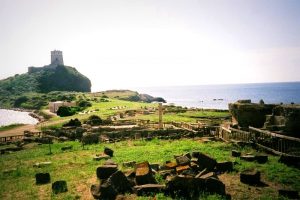
NUR means “light” and the city has a “lighthouse”. Therefore, the city named NORA was indeed a “NUR EVI” meaning “house of light” or “lighthouse”. In this picture, we still see the Sardinian national color of “yellow” still remaining on the stones. We must also note that the site where the lighthouse is located is a “HILL” (TEPE, BAŞ) shape. (Picture is from http://www.freewebs.com/zzzland/ruinsofnorasardinia.htm)
(See also Capo di Pula pictures at http://www.sea-seek.com/?geo=4299)
The Italian word CAPO, meaning “head; mind”, in the name Capo di Pula, is also linguistically interesting. In the context of “head; mind”, CAPO (KAPO) is from Turkish “KAFA” (TEPE, BAŞ)”head; mind”. As can be seen from the picture, the place where the tower is located makes up a “hill” (tepe, kafa) appearance with respect to its environment.
Thus we again have a linguistic connection with Turkish.
Additionally, another meaning of this word CAPO must be very much in line with the meaning of the Turkish word “KAPU” (KAPI) meaning “gate”. A harbour place is also a “gate” to a country. The Italian word PORTO means “harbour” (port). PORT and PORTICO (meaning “entrance, porch”) are related words in Italian. But the word PORTICO, rearranged as “COPOTIR”, is the altered and restructured form of Turkish word “KAPUTIR” (KAPITUR) meaning “it is gate”. Thus, I say this Italian word CAPO is also the same as Turkish KAPU and Turkish KAFA.
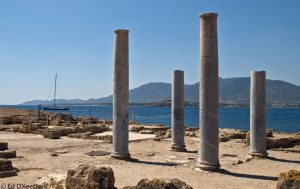
These columns are made in the same style as those found in the Minoan city of KONOSSOS. These columns of ancient NORA are Turanian round shaped columns indicating that the city was a Turanian city. (See picture at http://www.dilos.com/region/crete/knossos_propylea.html)
Figure 3. Sardinian “yellow” (i.e., SARI in Turkish) houses. This color is very much the color of “GINA” (henna, khenna) that Turkish girls put on their hands before their wedding night – (i.e., “GINA GECESI” in Turkish). So does the bridegroom.
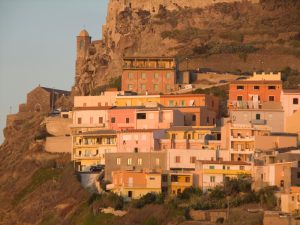
The term GINA probably gets its name from the Turkish word “GÜNO” meaning
“it is sun”. The Phoenicians were also called by the name KHNA, that is, the SUN (GÜN) people. Phoenicians were Turkish GÜNHANS! Turks are also known as AL BAŞ meaning “red head”.
Phoenicians were also known as “red people”. So the ancient sun worshipping
by Turanians probably influenced this GINA tradition as well!
***
Sardinian – Phoenician Connection:
First, let us understand the people who were named PHOENICIAN by the ancient Greeks.
http://en.wikipedia.org/wiki/Phoenicia
“Phoenicia (UK play /fɨˈnɪʃə/, US /fəˈniːʃə/;[2] from the Greek: Φοινίκη: Phoiníkē), was an ancient civilization in Canaan which covered most of the western, coastal part of the Fertile Crescent. Several major Phoenician cities were built on the coastline of the Mediterranean. It was an enterprising maritime trading culture that spread across the Mediterranean from 1550 BC to 300 BC. The Phoenicians used the galley, a man-powered sailing vessel, and are credited with the invention of the bireme.[3] They were famed in Classical Greece and Rome as ‘traders in purple’, referring to their monopoly on the precious purple dye of the Murex snail, used, among other things, for royal clothing, and for their spread of the alphabet (or abjad), upon which all major modern alphabets are derived.
In the Amarna tablets of the 14th century BC, people from the region called themselves Kenaani or Kinaani (Canaanites), although these letters predate the invasion of the Sea Peoples by over a century. Much later, in the 6th century BC, Hecataeus of Miletus writes that Phoenicia was formerly called χνα, a name Philo of Byblos later adopted into his mythology as his eponym for the Phoenicians: “Khna who was afterwards called Phoinix”.[4] Egyptian seafaring expeditions had already been made to Byblos to bring back “cedars of Lebanon” as early as the third millennium BC.
“Phoenicia” is really a Classical Greek term used to refer to the region of the major Canaanite port towns, and does not correspond exactly to a cultural identity that would have been recognised by the Phoenicians themselves. It is uncertain to what extent the Phoenicians viewed themselves as a single ethnicity. Their civilization was organized in city-states, similar to ancient Greece.[5] However in terms of archaeology, language, life style and religion, there is little to set the Phoenicians apart as markedly different from other cultures of Canaan. As Canaanites, they were unique in their remarkable seafaring achievements.”
The name PHOENICIAN, rearranged as “CONHAN-PEII”, is the altered, restructured and Hellenized form of the Turkish name “GÜNHAN BEYI” meaning “Günhan Lord”, that is, “Sun-God Lord”.KINAANI which is from Turkish GÜNHANI meaning “Sun Lords”, and additionally they were also called by the Semitized name CANAANITE which is the altered, restructured and Semitized form of the Turkish name “GÜNHAN IDI” meaning “they were Günhan peoples”. The name KHNA is the altered and Semitized form of Turkish “KÜN O””it is sun” in one hand. Additionally KHNA is also related to the Turkish word GINA (i.e., HENNA) which is a reddish colored die that ancient Turks traditionally used in order to color their hair and hands a reddish color. Phoenicians (Günhans) were also fames for their royal “purple color”, that is, “MOR” in Turkish and it was produced from the sea mollusk called “MUREX”. Note the Turkish MOR and MUR in Murex.
The name PHOENICIAN, rearranged as “PHENCI-ÖYAN” meaning “FENCI ÖYLER meaning “Houses of science”. This definition in Turkish identifies the Phoenicians as the scientifically learned people. The Figure 4 below shows these ancient Turanian Günhan Tur/Turk/Oguz peoples in their clean shaven face and long conical head dresses. Even at present , the Turkish AL BAŞ “Whirling Dervishes” wear the same hat.
This name verifies the fact that they called themselves meaning
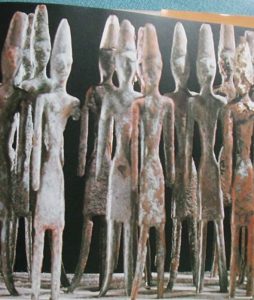
Figure 4. Agroup of Phoenician (Turanian Turkish Günhans) gods, discovered in the foundations of the Obelisk Temple at Byblos (Lebanon), dates from the 19th century B. C., when the Egyptians established their control over the ports on the east coast of the Mediterranean Sea. (From book “The World of the PHARAOHS” by Henri Stierlin, p. 24-25).
Phoenicians, who were the Turanian Turkish peoples named GÜNHANS, name of the first son of Oguz Kagan, were man of science, reading, writing and schooling. Thus they were the enlightened peoples whose alphabetic symbols (damga in Turkish) were taken by the Greeks and the Semites to enlighten themselves. We must note the ancient Turanian “conical hat” that is worn by all of them. The conical hat which is a Turanian symbol of “AL TEPE” (AYDIN TEPE) meaning “enlightened head”. It was also the symbol of the Sky-God and the Sun-God which lighted up the world and everything around it. These bronze statuttes are wearing red conical hats and their bodies are also colored in red. This is because they were Sun worshipping peoples. The Turkish term “AL TEPE” (KIZIL BAŞ) has been altered and Semitized as BETEL, or Aryanized as BETYL and BETILE meaning “house of God”.
***
It is said that the Phoenicians had contributed to the founding of the Sardinian city of NORA. This is expected because Sardinians, Corsicans (Kor Sakalar), Etruscans, Phoenicians, Troyans, Minoans and the rest of the Pelasgians were all Turanian peoples who were kin to each other. They were the “SAKA TURKS” meaning the “Water Turks, Seagoing Turks”. They were all branches of the same family tree.
Here, with respect to the name NORA, it is useful to remember the mythological Phoenician princess EUROPA whose Phoenician king father had the name AGENOR. The name AGENOR sounds very much like the Sardinian names NORA and NURAGHE. Europa mythologically was supposedly abducted by ZEUS who brought her to the island of Crete. Princess EUROPA was from the Phoenician city of so-called TYRE, that is, “TYR-E” which is the altered form of Turkish “TUR Evi” meaning “house of TUR”. This is exactly the same as the name TROY of Trojans – where TROY is the altered form of “TUR ÖY” meaning “house of Tur”!
The name AGENOR, rearranged as “AGE-NOR”, is from the Turkish name “AGA NUR” (NUR AGA, NUR BEY) meaning “Lord of Light” or “Light Lord”. In one hand this refers to the SUN that lights up everything, and alternatively, it refers to the “human head” – which enlightens man!
Similarly, the name AGENOR, rearranged as “GON ARE”, is from the Turkish name “GÜN ERI” meaning “sun man” (sun believer, believer of the light; believer of enlightenment; soldier of sun; hero of sun”. The King AGENOR was the king of Turkish GÜNHANS, that is, the Semitized name “CANAANITES” and the Hellenized so-called name “PHOENICIAN”. Therefore, as “sun and enlightenment” believing people, it was natural for this Phoenician king to have the name “GÜN ERI” meaning “the sun man”. Even nowadays, the names “GÜNER” and “GÜNERI” are used as Turkish male names and last names.
But more importantly, the name AGENOR has another meaning in Turkish. That we find when we decipher the name AGENOR as “OGENAR”. In this case the name AGENOR is an altered form of the Turkish word “OKUNUR” meaning “that which is read”. This of course refers to the written works which are read. Phoenicians produced alphabetically (i.e., so-called “abjad”) written books that were read. In other words, in a way, the mythical name AGENOR was a personification of the “written material” and, thus, that of “writing”. Ancient Greeks got writing from the Phoenicians, that is, the Günhan Turks! The term “ABJAD” comes from the names of the first four characters in the Turkish alphabet, that is, A, Be, Ce, De – all concatenated to make ABECEDE. This forms the word ABCAD – which is then Semitized into “ABJAD”!
Furthermore, the name AGENOR, rearranged as “NURE-AG”, is from Turkish name “NURI AGA” meaning “Lord Nuri” (Nuri Bey) where the name NURI is a name for Turkish men. NURI also means “enlightened man”.
With this insight and understanding of the name AGENOR, we can now compare it with one decipherment of the Sardinian name NURAGHE. The name NURAGHE, rearranged as “NUR-AGHE”, is from the Turkish name “NUR AGA” again meaning “Lord light” or “Light Lord”. This is also a symbolization of 1) the light-giving Sun and 2) the enlightened “human head”!
In Greek mythology, king AGENOR was mythologically the twin-brother of BELUS, and the father of Cadmus and Europa.
The Greek name BELUS (who was the twin-brother of AGENOR, that is, OKUNUR in Turkish), is the altered, restructured and Hellenized form of the Turkish word “BILIŞ” – meaning “it is knowing, it is knowledge”. Thus the so-called Greek mythologic name BELUS was actually a personification of “knowledge” – but in Turkish. Indeed when we read written material, we learn information from it – which is “knowledge”. Thus, AGENOR (i.e., OKUNUR in Turkish) and BELUS (i.e., “BILIŞ” in Turkish) are definitely twin brother concepts. They cannot be separated from each other. One reads and one learns! So the source of all this so-called ancient Greek mythology was in Turkish and they were stolen by way of ciphering the Turkish concepts described by Turkish words and phrases! Also we note that in mythology, what one sees on the surface can be a very different thing or concept than what the ancients meant allegorically. Hence, they can be totally different concepts!
Furthermore, the name BELUS, rearranged as “BEL-US”, is the restructured form of the Turkish expression “BIL” and “US” meaning “knowledge” and “wisdom” respectively. “BIL” and “US” are again found at the “head of man”.
From all of this, we see that ancient Greek mythology has not told us anything truthfully. In one hand, they kept in the dark the knowledge and civilization of the ancient Turanian Tur/Turk/Oguz peoples – thereby obliterating that ancient Turanian civilization, and in the other hand, they usurped that civilization (i.e., its knowledge, it science, it schools, its language, its teachings, its canons, its religion etc,) and presented it in a modified fashion – as if it was their own! Many Turanian concepts, traditions and knowledge were presented in a new form as riddles (e.g., AGENOR and BELUS just above).
Turkish word BIL means “know” which is the root of verb ‘bilmek’ meaning “to know”, BILGI means “knowledge” and BILGE means “knowledgable”. From BILGE comes another Turkish word “AKIL” meaning “1. reason, intelligence; wisdom, discernment, discretion. 2. mind, comprehension, memory. 3. idea, opinion, thought. 4. prudence. 5. maturity, age of discretion.”
In Greek mythology, the Greek name CADMUS (who was the son of AGENOR (OKUNUR)), rearranged as “UASMCD”, is the altered, restructured and Hellenized form of the Turkish word “YAZMaKDi” meaning “it is writing”. Of course, what is read (OKUNUR in Turkish) refers to the written works, that is, books, writings on stone, etc. Turkish word “YAZI” means “writing, words that are written in some form of writing”. Writing and reading, knowledge and enlightenment are all related kin concepts! But these names and the concepts that they personified have been mythologically put into riddles that have never been properly explained or understood.
In view of all these concepts, let us now get back to the name of the mythological Phoenician princess EUROPA whose Phoenician king father had the name AGENOR.
a) In one meaning, the name EUROPA, rearranged as “EU-PAR-O”, is the altered and Hellenized form of the Turkish expression “EYI PARA O” meaning “it is good money”. Supposedly, the name of “EUROPE” was from the name of the Phoenician (Günhan) Princess EUROPA. Phoenicians commercially were very advanced and hence rich people. When the mythological name Zeus (Turkish SÖZ) eloped with the Phoenician Princess EUROPA, the Greeks actually usurped the Phoenician school system, and with it, the “good money making” system.
Indeed, since ancient times, he who had studied in schools and learned how to read and write always earned good positions in the government establishments, in schools and also in the commercial establishments, therefore, they made good money compared to the illiterate farmers! So, I say that mythologically, the name EUROPA was a personification of the “God/Goddess” concept in one hand, and the personification of “money” in the other. But all of these linguistic manipulations were done on Turkish words and phrases!
Turkish word EYI (IYI) means “good”, PARA means “money”, BIR means “One”, BIR O means “God”.
Curiously, the EURO is the current name of the monetary unit of Europe!
Additionally, we have the following meanings embedded within this name EUROPA:
b) The name EUROPA, rearranged as “PAR-O-UE”, is the altered and Hellenized form of a Turkish expression “BIR-O ÖYÜ” meaning “House of One God”. In this context, it is the name of the so-called continent of “EUROPE” which is coined and based on ancient Turanian religious concepts.
In ancient Syria, the word for God was also “BAR” (BIR) as an alternative to “BAAL”, [see “An Egyptian Hieroglyphic Dictionary” by E. A. Wallis Budge, p. 203b”]. So, again it was a Turanian word. The name SYRIA – (SURIYE in Turkish) is a name that has been altered from the original Turkish word “TURIYE” meaning “home of Turs”, “land of Turs”. The Phoenician city of TYRE, that is, “TYR-E” (TUR EVI) is presently known as SUR in Turkish. So, there has been a T to S “mistranslation” in changing the ancient Turanian name.
c) In the context that EUROPA was the name of a Phoenician princess, the name EUROPA, rearranged as “PERUA-O”, is the altered, restructured form of the Turkish expression “PERUyA O” (BIROyA)” meaning “goddess”.
The name PERU (Semitized as “PHARAOH”) was the godly title of the ancient Masarian (so-called “EGYPT”) “god kings”. But PERU is another form of the Turkish word “BIR O” – meaning “One God”. PERUYA would be the feminized form of the name PERU, thus, meaning “goddess”. PERU is also a form of the Turkish girl’s name PERI meaning “fairy”.
***
In concluding this section, we can confidently say that the ancient world was a Turanian Tur/Turk world, and in this context, the so-called “Mediterranean Sea” was a Turanian ‘lake’ surrounded by many clans of the Turanian Tur/Turk/Oguz peoples – contrary to the totally distorted and false picture presented to us all by the “ancient” history writers. The present European civilization not only got everything from the ancient Turanian civilization but also, is populated by countless numbers of ancient Turanian Tur/Turk/Oguz peoples who have all been converted to Christianity – and their names and identities Aryanized. Of course, their ancient Turanian language of Turkish was totally confused by the Aryan clergy – while the “Aryan” languages were fabricated from it – and forced onto the native
Turanians!
Polat Kaya
15/11/2011
http://www.polatkaya.net/Sardinian_Capital_City_Nora.html

